Strategic Management Report: Analyzing Uber's Business and Strategies
VerifiedAdded on 2021/04/16
|17
|4442
|69
Report
AI Summary
This report provides a comprehensive strategic analysis of Uber, examining its business environment through the application of various analytical tools such as Porter's Five Forces and PESTEL analysis. It assesses Uber's strategic resources and capabilities, including its technology, application, and business model. The report identifies key issues faced by Uber and proposes strategic solutions, culminating in an evaluation of these proposals. It also includes a Business Model Canvas, Value Chain analysis, and VRIN framework to understand Uber's competitive advantages. The report concludes with an evaluation of Uber's strategies and implications for its future success and sustainability in the UK market, considering factors such as safety, legal regulations, and customer service improvements. The report also covers the implications for Uber's long-term survival and success in the UK market.

Strategic
Management
win
Management
win
Paraphrase This Document
Need a fresh take? Get an instant paraphrase of this document with our AI Paraphraser
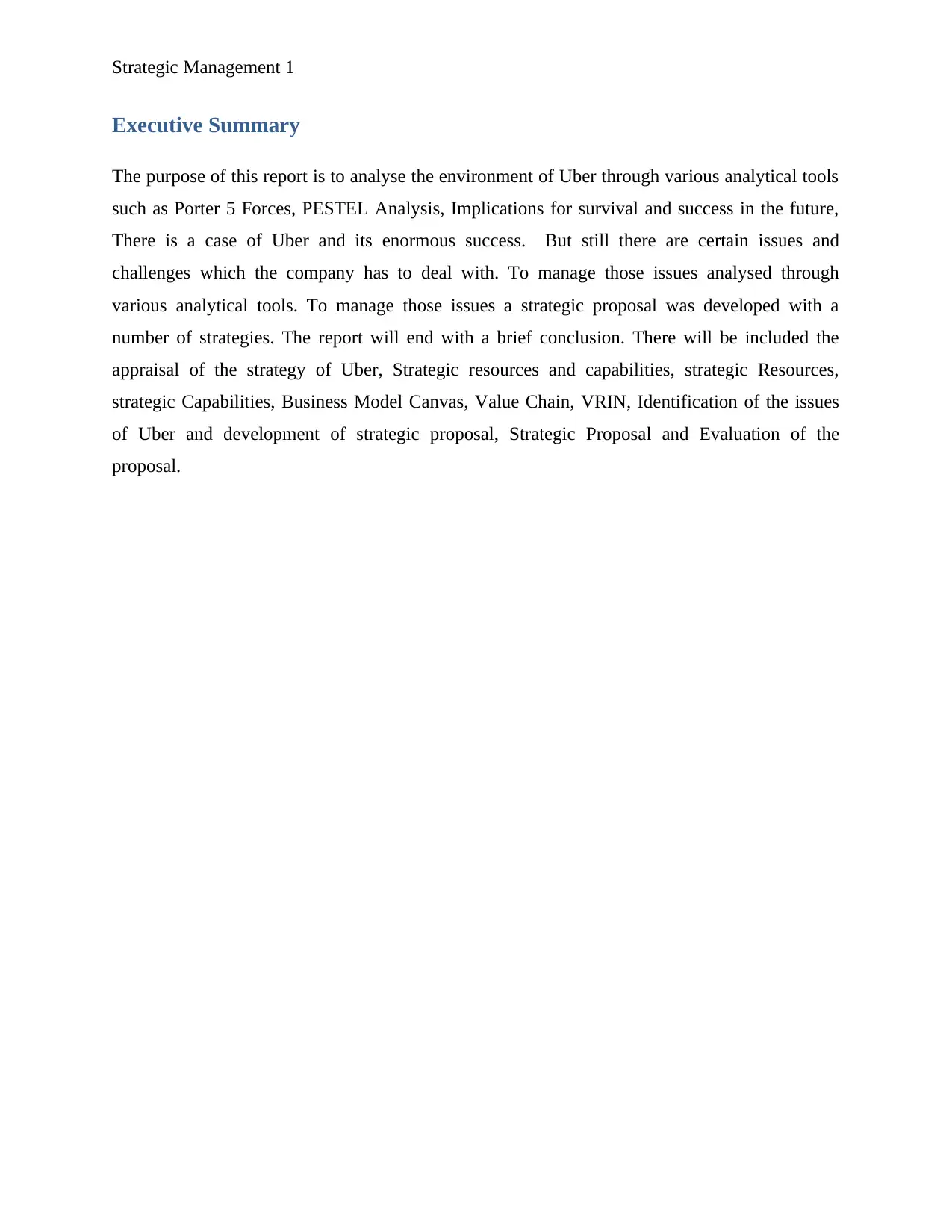
Strategic Management 1
Executive Summary
The purpose of this report is to analyse the environment of Uber through various analytical tools
such as Porter 5 Forces, PESTEL Analysis, Implications for survival and success in the future,
There is a case of Uber and its enormous success. But still there are certain issues and
challenges which the company has to deal with. To manage those issues analysed through
various analytical tools. To manage those issues a strategic proposal was developed with a
number of strategies. The report will end with a brief conclusion. There will be included the
appraisal of the strategy of Uber, Strategic resources and capabilities, strategic Resources,
strategic Capabilities, Business Model Canvas, Value Chain, VRIN, Identification of the issues
of Uber and development of strategic proposal, Strategic Proposal and Evaluation of the
proposal.
Executive Summary
The purpose of this report is to analyse the environment of Uber through various analytical tools
such as Porter 5 Forces, PESTEL Analysis, Implications for survival and success in the future,
There is a case of Uber and its enormous success. But still there are certain issues and
challenges which the company has to deal with. To manage those issues analysed through
various analytical tools. To manage those issues a strategic proposal was developed with a
number of strategies. The report will end with a brief conclusion. There will be included the
appraisal of the strategy of Uber, Strategic resources and capabilities, strategic Resources,
strategic Capabilities, Business Model Canvas, Value Chain, VRIN, Identification of the issues
of Uber and development of strategic proposal, Strategic Proposal and Evaluation of the
proposal.
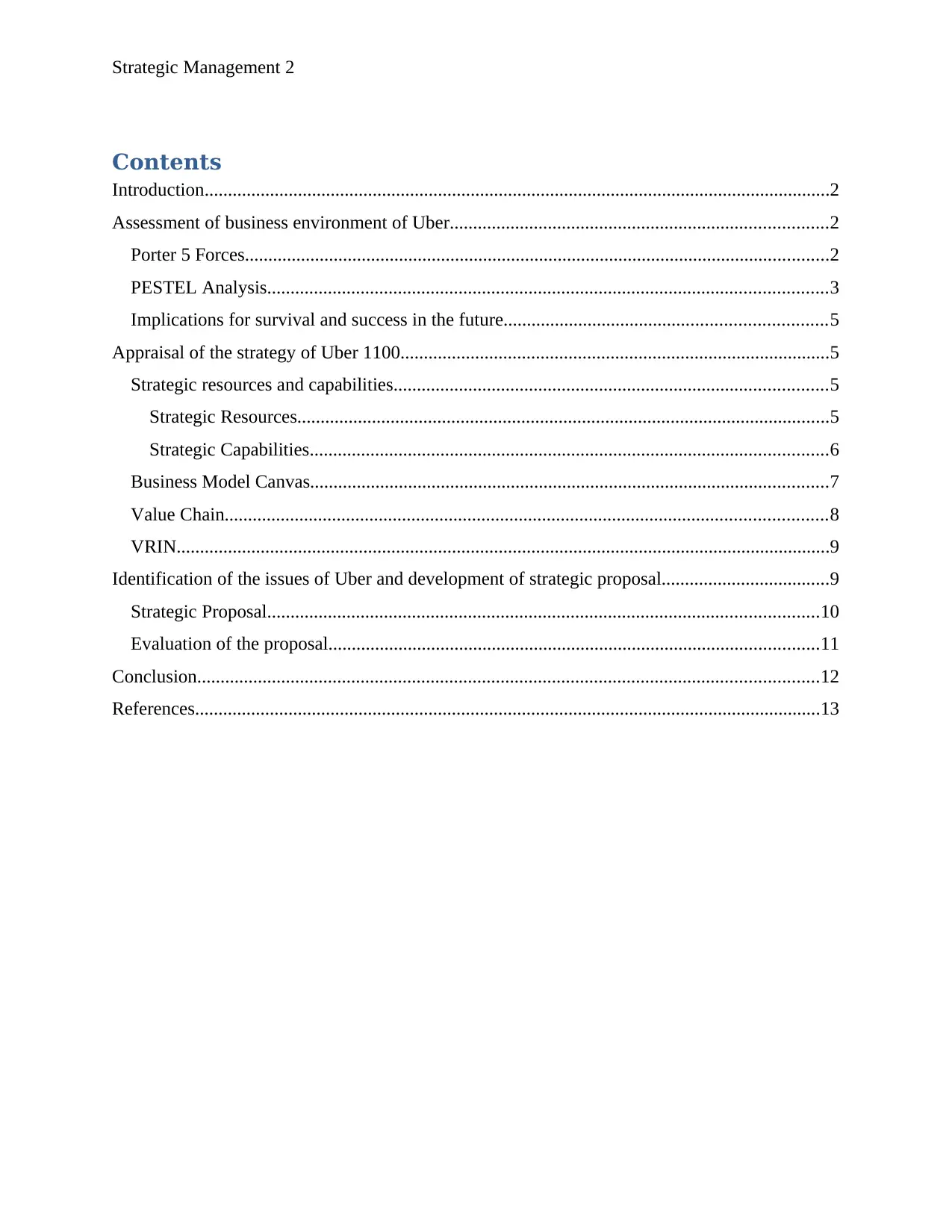
Strategic Management 2
Contents
Introduction......................................................................................................................................2
Assessment of business environment of Uber.................................................................................2
Porter 5 Forces.............................................................................................................................2
PESTEL Analysis........................................................................................................................3
Implications for survival and success in the future.....................................................................5
Appraisal of the strategy of Uber 1100............................................................................................5
Strategic resources and capabilities.............................................................................................5
Strategic Resources..................................................................................................................5
Strategic Capabilities...............................................................................................................6
Business Model Canvas...............................................................................................................7
Value Chain.................................................................................................................................8
VRIN............................................................................................................................................9
Identification of the issues of Uber and development of strategic proposal....................................9
Strategic Proposal......................................................................................................................10
Evaluation of the proposal.........................................................................................................11
Conclusion.....................................................................................................................................12
References......................................................................................................................................13
Contents
Introduction......................................................................................................................................2
Assessment of business environment of Uber.................................................................................2
Porter 5 Forces.............................................................................................................................2
PESTEL Analysis........................................................................................................................3
Implications for survival and success in the future.....................................................................5
Appraisal of the strategy of Uber 1100............................................................................................5
Strategic resources and capabilities.............................................................................................5
Strategic Resources..................................................................................................................5
Strategic Capabilities...............................................................................................................6
Business Model Canvas...............................................................................................................7
Value Chain.................................................................................................................................8
VRIN............................................................................................................................................9
Identification of the issues of Uber and development of strategic proposal....................................9
Strategic Proposal......................................................................................................................10
Evaluation of the proposal.........................................................................................................11
Conclusion.....................................................................................................................................12
References......................................................................................................................................13
⊘ This is a preview!⊘
Do you want full access?
Subscribe today to unlock all pages.

Trusted by 1+ million students worldwide
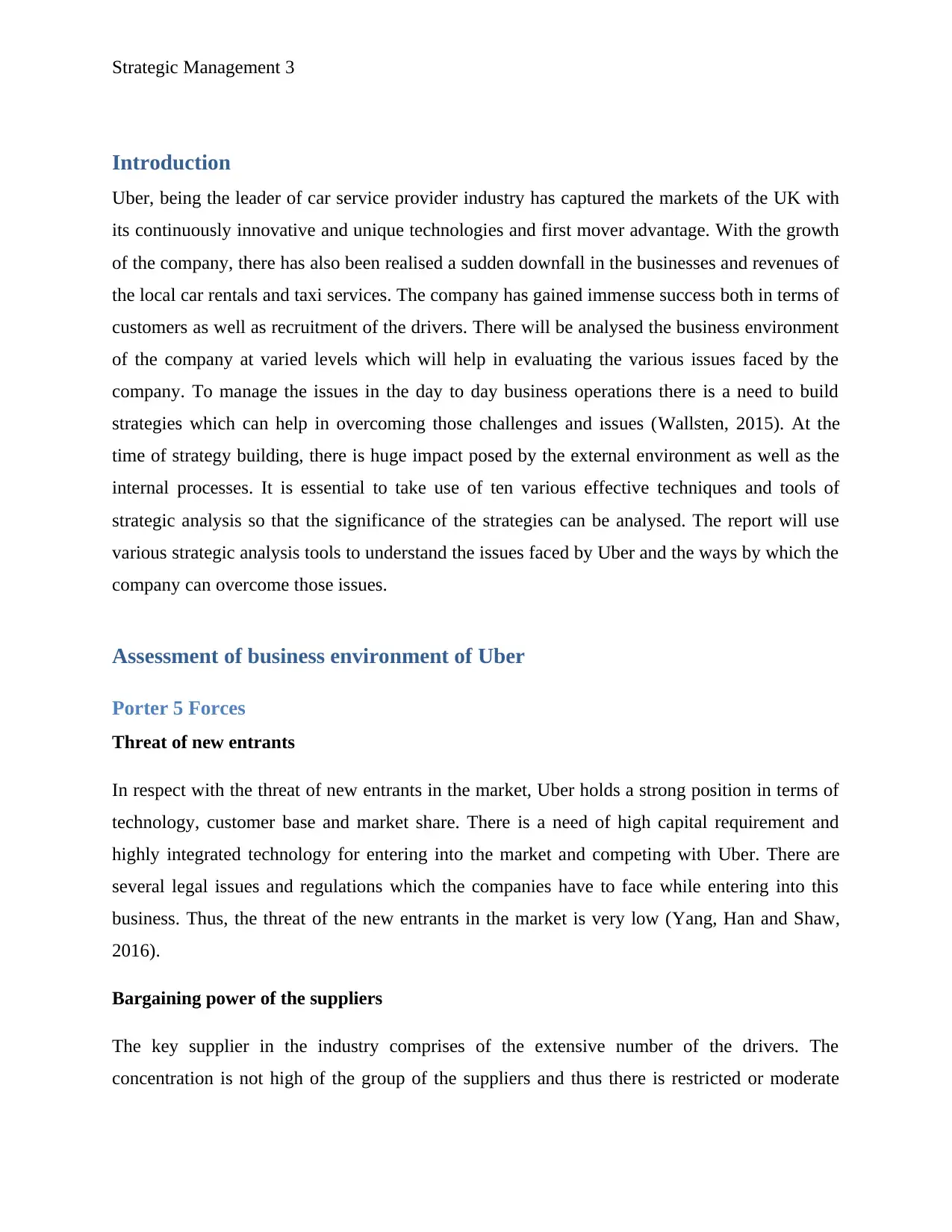
Strategic Management 3
Introduction
Uber, being the leader of car service provider industry has captured the markets of the UK with
its continuously innovative and unique technologies and first mover advantage. With the growth
of the company, there has also been realised a sudden downfall in the businesses and revenues of
the local car rentals and taxi services. The company has gained immense success both in terms of
customers as well as recruitment of the drivers. There will be analysed the business environment
of the company at varied levels which will help in evaluating the various issues faced by the
company. To manage the issues in the day to day business operations there is a need to build
strategies which can help in overcoming those challenges and issues (Wallsten, 2015). At the
time of strategy building, there is huge impact posed by the external environment as well as the
internal processes. It is essential to take use of ten various effective techniques and tools of
strategic analysis so that the significance of the strategies can be analysed. The report will use
various strategic analysis tools to understand the issues faced by Uber and the ways by which the
company can overcome those issues.
Assessment of business environment of Uber
Porter 5 Forces
Threat of new entrants
In respect with the threat of new entrants in the market, Uber holds a strong position in terms of
technology, customer base and market share. There is a need of high capital requirement and
highly integrated technology for entering into the market and competing with Uber. There are
several legal issues and regulations which the companies have to face while entering into this
business. Thus, the threat of the new entrants in the market is very low (Yang, Han and Shaw,
2016).
Bargaining power of the suppliers
The key supplier in the industry comprises of the extensive number of the drivers. The
concentration is not high of the group of the suppliers and thus there is restricted or moderate
Introduction
Uber, being the leader of car service provider industry has captured the markets of the UK with
its continuously innovative and unique technologies and first mover advantage. With the growth
of the company, there has also been realised a sudden downfall in the businesses and revenues of
the local car rentals and taxi services. The company has gained immense success both in terms of
customers as well as recruitment of the drivers. There will be analysed the business environment
of the company at varied levels which will help in evaluating the various issues faced by the
company. To manage the issues in the day to day business operations there is a need to build
strategies which can help in overcoming those challenges and issues (Wallsten, 2015). At the
time of strategy building, there is huge impact posed by the external environment as well as the
internal processes. It is essential to take use of ten various effective techniques and tools of
strategic analysis so that the significance of the strategies can be analysed. The report will use
various strategic analysis tools to understand the issues faced by Uber and the ways by which the
company can overcome those issues.
Assessment of business environment of Uber
Porter 5 Forces
Threat of new entrants
In respect with the threat of new entrants in the market, Uber holds a strong position in terms of
technology, customer base and market share. There is a need of high capital requirement and
highly integrated technology for entering into the market and competing with Uber. There are
several legal issues and regulations which the companies have to face while entering into this
business. Thus, the threat of the new entrants in the market is very low (Yang, Han and Shaw,
2016).
Bargaining power of the suppliers
The key supplier in the industry comprises of the extensive number of the drivers. The
concentration is not high of the group of the suppliers and thus there is restricted or moderate
Paraphrase This Document
Need a fresh take? Get an instant paraphrase of this document with our AI Paraphraser
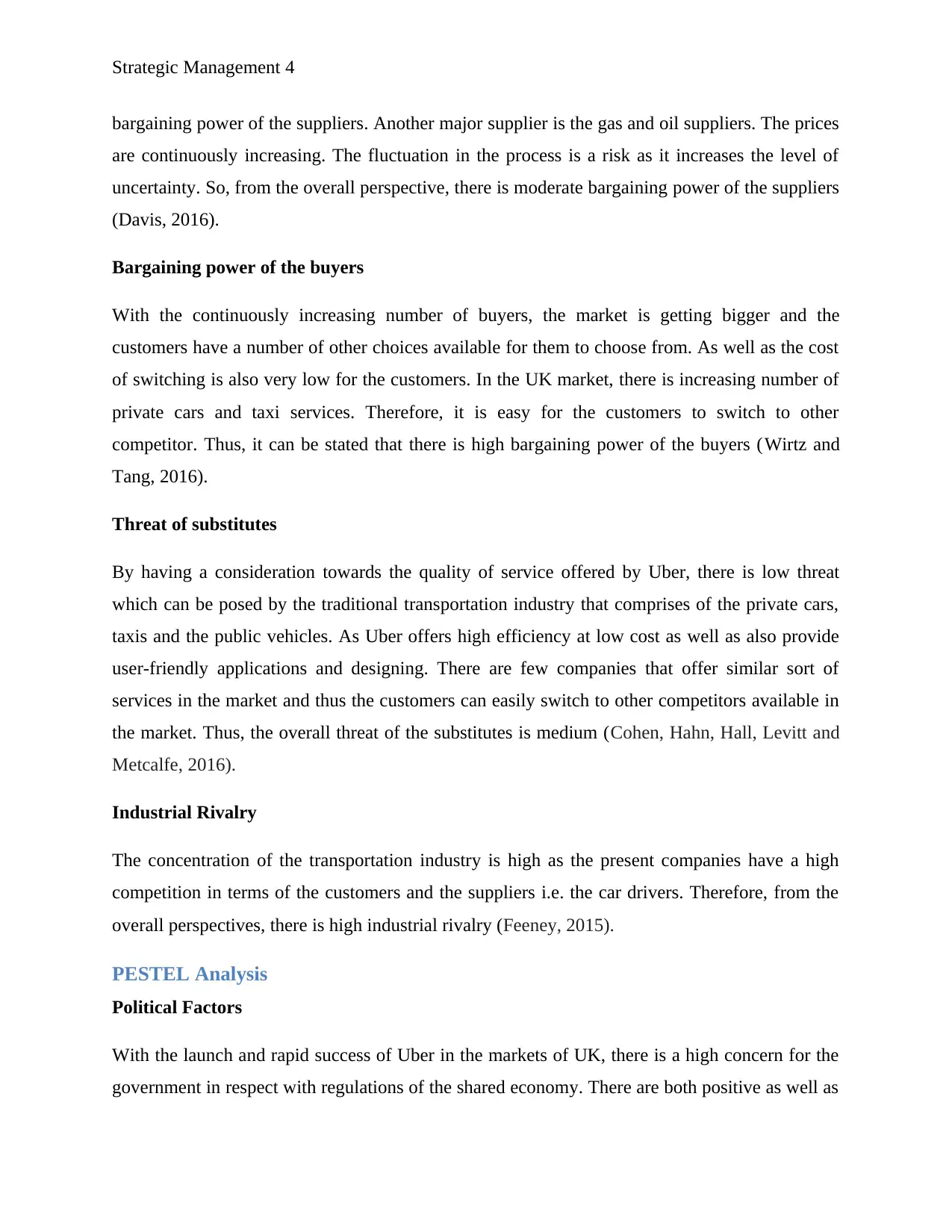
Strategic Management 4
bargaining power of the suppliers. Another major supplier is the gas and oil suppliers. The prices
are continuously increasing. The fluctuation in the process is a risk as it increases the level of
uncertainty. So, from the overall perspective, there is moderate bargaining power of the suppliers
(Davis, 2016).
Bargaining power of the buyers
With the continuously increasing number of buyers, the market is getting bigger and the
customers have a number of other choices available for them to choose from. As well as the cost
of switching is also very low for the customers. In the UK market, there is increasing number of
private cars and taxi services. Therefore, it is easy for the customers to switch to other
competitor. Thus, it can be stated that there is high bargaining power of the buyers (Wirtz and
Tang, 2016).
Threat of substitutes
By having a consideration towards the quality of service offered by Uber, there is low threat
which can be posed by the traditional transportation industry that comprises of the private cars,
taxis and the public vehicles. As Uber offers high efficiency at low cost as well as also provide
user-friendly applications and designing. There are few companies that offer similar sort of
services in the market and thus the customers can easily switch to other competitors available in
the market. Thus, the overall threat of the substitutes is medium (Cohen, Hahn, Hall, Levitt and
Metcalfe, 2016).
Industrial Rivalry
The concentration of the transportation industry is high as the present companies have a high
competition in terms of the customers and the suppliers i.e. the car drivers. Therefore, from the
overall perspectives, there is high industrial rivalry (Feeney, 2015).
PESTEL Analysis
Political Factors
With the launch and rapid success of Uber in the markets of UK, there is a high concern for the
government in respect with regulations of the shared economy. There are both positive as well as
bargaining power of the suppliers. Another major supplier is the gas and oil suppliers. The prices
are continuously increasing. The fluctuation in the process is a risk as it increases the level of
uncertainty. So, from the overall perspective, there is moderate bargaining power of the suppliers
(Davis, 2016).
Bargaining power of the buyers
With the continuously increasing number of buyers, the market is getting bigger and the
customers have a number of other choices available for them to choose from. As well as the cost
of switching is also very low for the customers. In the UK market, there is increasing number of
private cars and taxi services. Therefore, it is easy for the customers to switch to other
competitor. Thus, it can be stated that there is high bargaining power of the buyers (Wirtz and
Tang, 2016).
Threat of substitutes
By having a consideration towards the quality of service offered by Uber, there is low threat
which can be posed by the traditional transportation industry that comprises of the private cars,
taxis and the public vehicles. As Uber offers high efficiency at low cost as well as also provide
user-friendly applications and designing. There are few companies that offer similar sort of
services in the market and thus the customers can easily switch to other competitors available in
the market. Thus, the overall threat of the substitutes is medium (Cohen, Hahn, Hall, Levitt and
Metcalfe, 2016).
Industrial Rivalry
The concentration of the transportation industry is high as the present companies have a high
competition in terms of the customers and the suppliers i.e. the car drivers. Therefore, from the
overall perspectives, there is high industrial rivalry (Feeney, 2015).
PESTEL Analysis
Political Factors
With the launch and rapid success of Uber in the markets of UK, there is a high concern for the
government in respect with regulations of the shared economy. There are both positive as well as
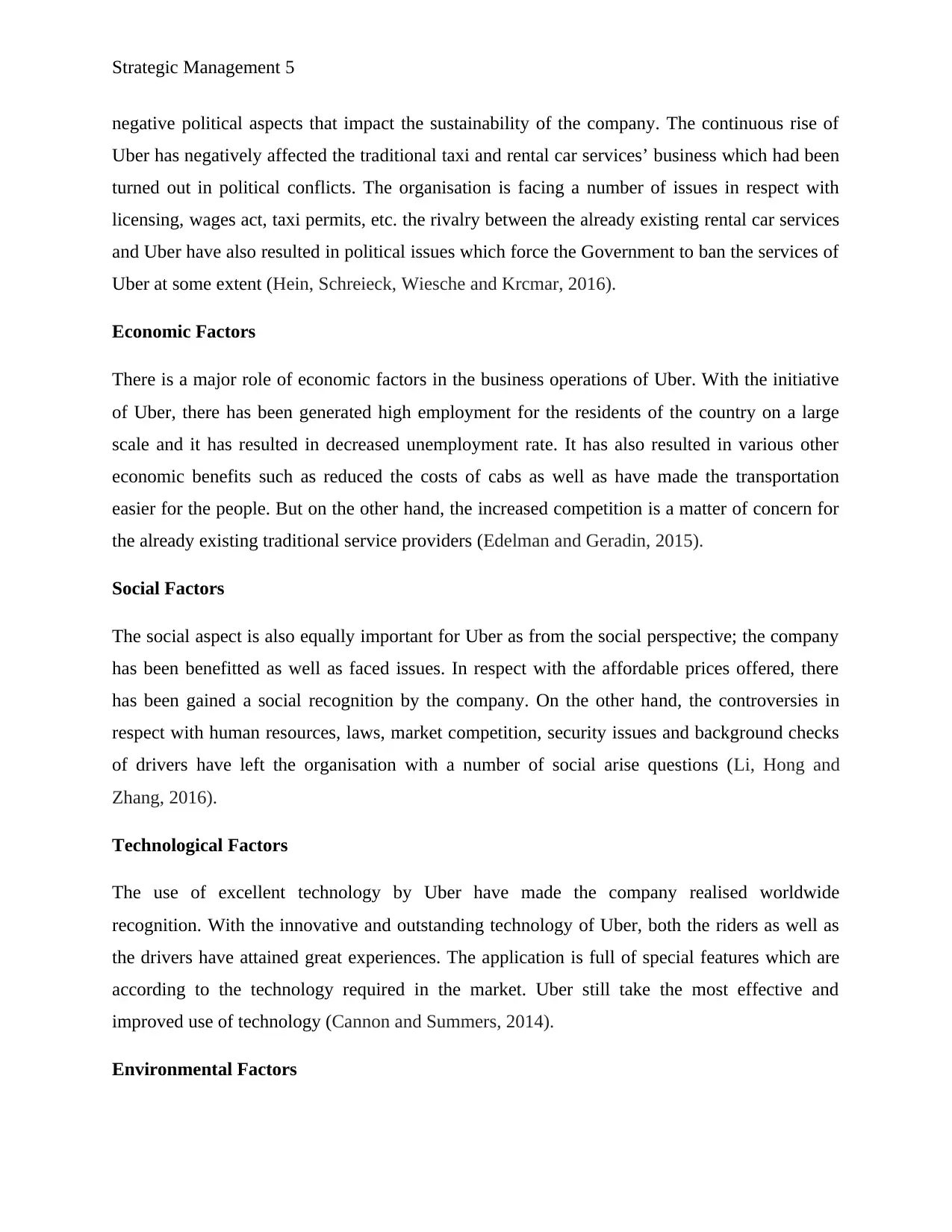
Strategic Management 5
negative political aspects that impact the sustainability of the company. The continuous rise of
Uber has negatively affected the traditional taxi and rental car services’ business which had been
turned out in political conflicts. The organisation is facing a number of issues in respect with
licensing, wages act, taxi permits, etc. the rivalry between the already existing rental car services
and Uber have also resulted in political issues which force the Government to ban the services of
Uber at some extent (Hein, Schreieck, Wiesche and Krcmar, 2016).
Economic Factors
There is a major role of economic factors in the business operations of Uber. With the initiative
of Uber, there has been generated high employment for the residents of the country on a large
scale and it has resulted in decreased unemployment rate. It has also resulted in various other
economic benefits such as reduced the costs of cabs as well as have made the transportation
easier for the people. But on the other hand, the increased competition is a matter of concern for
the already existing traditional service providers (Edelman and Geradin, 2015).
Social Factors
The social aspect is also equally important for Uber as from the social perspective; the company
has been benefitted as well as faced issues. In respect with the affordable prices offered, there
has been gained a social recognition by the company. On the other hand, the controversies in
respect with human resources, laws, market competition, security issues and background checks
of drivers have left the organisation with a number of social arise questions (Li, Hong and
Zhang, 2016).
Technological Factors
The use of excellent technology by Uber have made the company realised worldwide
recognition. With the innovative and outstanding technology of Uber, both the riders as well as
the drivers have attained great experiences. The application is full of special features which are
according to the technology required in the market. Uber still take the most effective and
improved use of technology (Cannon and Summers, 2014).
Environmental Factors
negative political aspects that impact the sustainability of the company. The continuous rise of
Uber has negatively affected the traditional taxi and rental car services’ business which had been
turned out in political conflicts. The organisation is facing a number of issues in respect with
licensing, wages act, taxi permits, etc. the rivalry between the already existing rental car services
and Uber have also resulted in political issues which force the Government to ban the services of
Uber at some extent (Hein, Schreieck, Wiesche and Krcmar, 2016).
Economic Factors
There is a major role of economic factors in the business operations of Uber. With the initiative
of Uber, there has been generated high employment for the residents of the country on a large
scale and it has resulted in decreased unemployment rate. It has also resulted in various other
economic benefits such as reduced the costs of cabs as well as have made the transportation
easier for the people. But on the other hand, the increased competition is a matter of concern for
the already existing traditional service providers (Edelman and Geradin, 2015).
Social Factors
The social aspect is also equally important for Uber as from the social perspective; the company
has been benefitted as well as faced issues. In respect with the affordable prices offered, there
has been gained a social recognition by the company. On the other hand, the controversies in
respect with human resources, laws, market competition, security issues and background checks
of drivers have left the organisation with a number of social arise questions (Li, Hong and
Zhang, 2016).
Technological Factors
The use of excellent technology by Uber have made the company realised worldwide
recognition. With the innovative and outstanding technology of Uber, both the riders as well as
the drivers have attained great experiences. The application is full of special features which are
according to the technology required in the market. Uber still take the most effective and
improved use of technology (Cannon and Summers, 2014).
Environmental Factors
⊘ This is a preview!⊘
Do you want full access?
Subscribe today to unlock all pages.

Trusted by 1+ million students worldwide
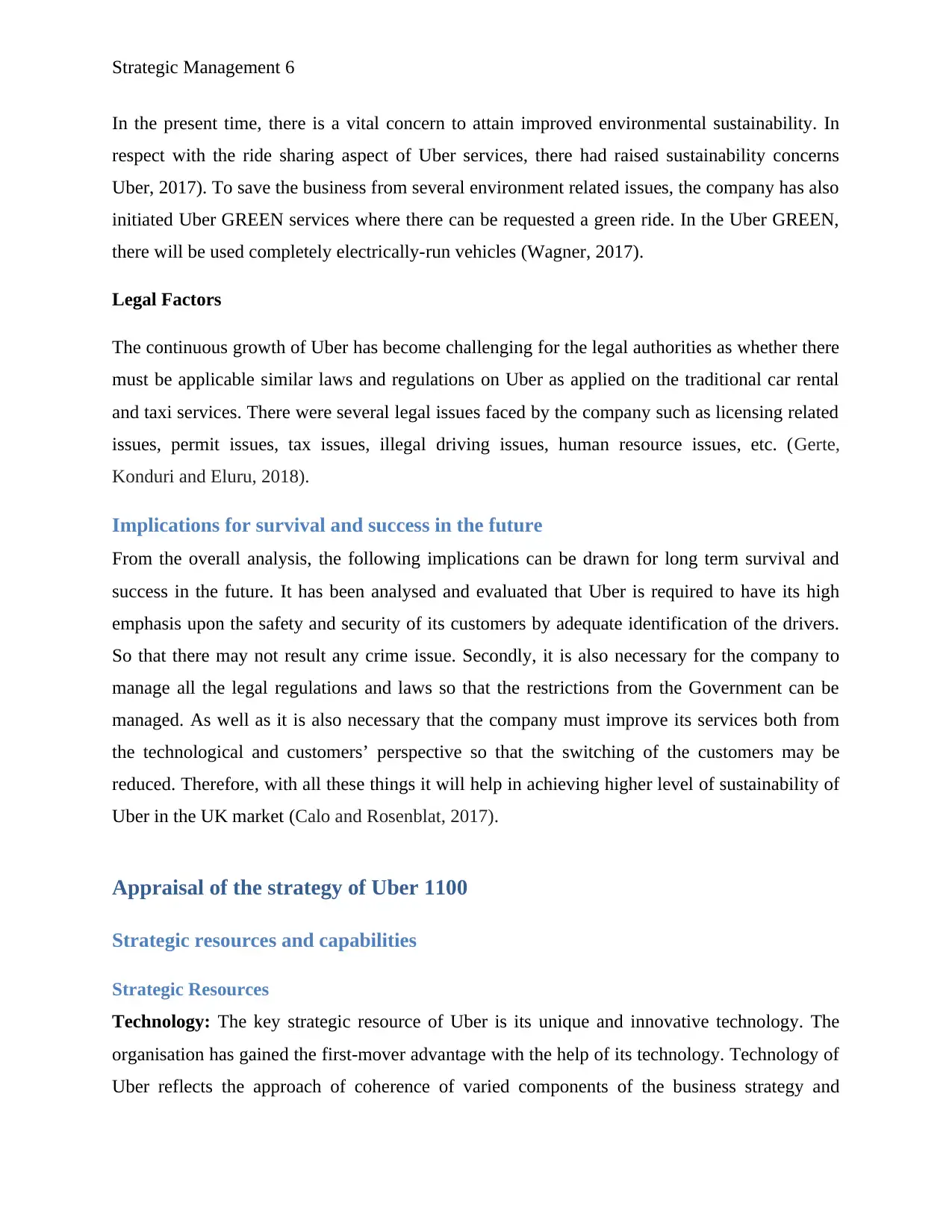
Strategic Management 6
In the present time, there is a vital concern to attain improved environmental sustainability. In
respect with the ride sharing aspect of Uber services, there had raised sustainability concerns
Uber, 2017). To save the business from several environment related issues, the company has also
initiated Uber GREEN services where there can be requested a green ride. In the Uber GREEN,
there will be used completely electrically-run vehicles (Wagner, 2017).
Legal Factors
The continuous growth of Uber has become challenging for the legal authorities as whether there
must be applicable similar laws and regulations on Uber as applied on the traditional car rental
and taxi services. There were several legal issues faced by the company such as licensing related
issues, permit issues, tax issues, illegal driving issues, human resource issues, etc. (Gerte,
Konduri and Eluru, 2018).
Implications for survival and success in the future
From the overall analysis, the following implications can be drawn for long term survival and
success in the future. It has been analysed and evaluated that Uber is required to have its high
emphasis upon the safety and security of its customers by adequate identification of the drivers.
So that there may not result any crime issue. Secondly, it is also necessary for the company to
manage all the legal regulations and laws so that the restrictions from the Government can be
managed. As well as it is also necessary that the company must improve its services both from
the technological and customers’ perspective so that the switching of the customers may be
reduced. Therefore, with all these things it will help in achieving higher level of sustainability of
Uber in the UK market (Calo and Rosenblat, 2017).
Appraisal of the strategy of Uber 1100
Strategic resources and capabilities
Strategic Resources
Technology: The key strategic resource of Uber is its unique and innovative technology. The
organisation has gained the first-mover advantage with the help of its technology. Technology of
Uber reflects the approach of coherence of varied components of the business strategy and
In the present time, there is a vital concern to attain improved environmental sustainability. In
respect with the ride sharing aspect of Uber services, there had raised sustainability concerns
Uber, 2017). To save the business from several environment related issues, the company has also
initiated Uber GREEN services where there can be requested a green ride. In the Uber GREEN,
there will be used completely electrically-run vehicles (Wagner, 2017).
Legal Factors
The continuous growth of Uber has become challenging for the legal authorities as whether there
must be applicable similar laws and regulations on Uber as applied on the traditional car rental
and taxi services. There were several legal issues faced by the company such as licensing related
issues, permit issues, tax issues, illegal driving issues, human resource issues, etc. (Gerte,
Konduri and Eluru, 2018).
Implications for survival and success in the future
From the overall analysis, the following implications can be drawn for long term survival and
success in the future. It has been analysed and evaluated that Uber is required to have its high
emphasis upon the safety and security of its customers by adequate identification of the drivers.
So that there may not result any crime issue. Secondly, it is also necessary for the company to
manage all the legal regulations and laws so that the restrictions from the Government can be
managed. As well as it is also necessary that the company must improve its services both from
the technological and customers’ perspective so that the switching of the customers may be
reduced. Therefore, with all these things it will help in achieving higher level of sustainability of
Uber in the UK market (Calo and Rosenblat, 2017).
Appraisal of the strategy of Uber 1100
Strategic resources and capabilities
Strategic Resources
Technology: The key strategic resource of Uber is its unique and innovative technology. The
organisation has gained the first-mover advantage with the help of its technology. Technology of
Uber reflects the approach of coherence of varied components of the business strategy and
Paraphrase This Document
Need a fresh take? Get an instant paraphrase of this document with our AI Paraphraser
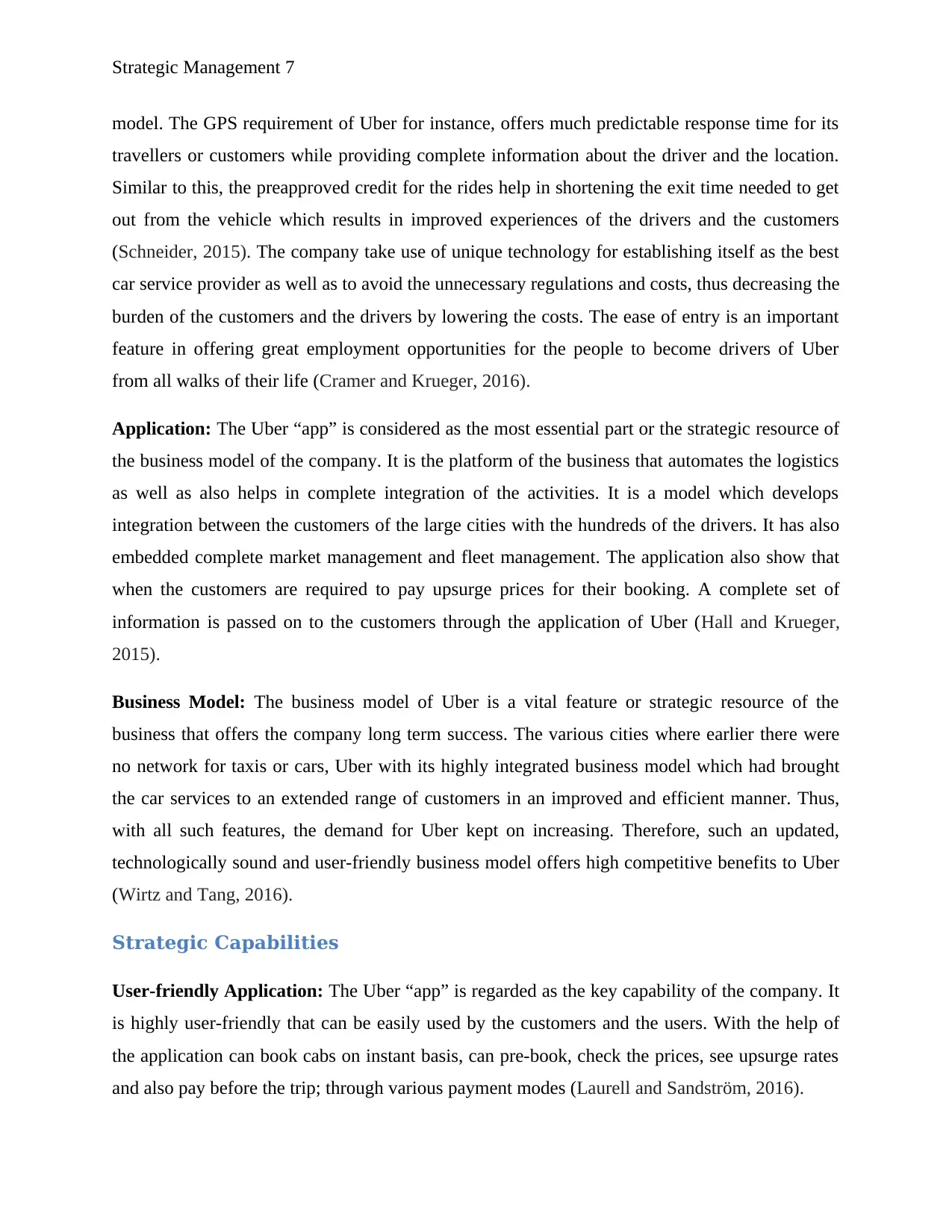
Strategic Management 7
model. The GPS requirement of Uber for instance, offers much predictable response time for its
travellers or customers while providing complete information about the driver and the location.
Similar to this, the preapproved credit for the rides help in shortening the exit time needed to get
out from the vehicle which results in improved experiences of the drivers and the customers
(Schneider, 2015). The company take use of unique technology for establishing itself as the best
car service provider as well as to avoid the unnecessary regulations and costs, thus decreasing the
burden of the customers and the drivers by lowering the costs. The ease of entry is an important
feature in offering great employment opportunities for the people to become drivers of Uber
from all walks of their life (Cramer and Krueger, 2016).
Application: The Uber “app” is considered as the most essential part or the strategic resource of
the business model of the company. It is the platform of the business that automates the logistics
as well as also helps in complete integration of the activities. It is a model which develops
integration between the customers of the large cities with the hundreds of the drivers. It has also
embedded complete market management and fleet management. The application also show that
when the customers are required to pay upsurge prices for their booking. A complete set of
information is passed on to the customers through the application of Uber (Hall and Krueger,
2015).
Business Model: The business model of Uber is a vital feature or strategic resource of the
business that offers the company long term success. The various cities where earlier there were
no network for taxis or cars, Uber with its highly integrated business model which had brought
the car services to an extended range of customers in an improved and efficient manner. Thus,
with all such features, the demand for Uber kept on increasing. Therefore, such an updated,
technologically sound and user-friendly business model offers high competitive benefits to Uber
(Wirtz and Tang, 2016).
Strategic Capabilities
User-friendly Application: The Uber “app” is regarded as the key capability of the company. It
is highly user-friendly that can be easily used by the customers and the users. With the help of
the application can book cabs on instant basis, can pre-book, check the prices, see upsurge rates
and also pay before the trip; through various payment modes (Laurell and Sandström, 2016).
model. The GPS requirement of Uber for instance, offers much predictable response time for its
travellers or customers while providing complete information about the driver and the location.
Similar to this, the preapproved credit for the rides help in shortening the exit time needed to get
out from the vehicle which results in improved experiences of the drivers and the customers
(Schneider, 2015). The company take use of unique technology for establishing itself as the best
car service provider as well as to avoid the unnecessary regulations and costs, thus decreasing the
burden of the customers and the drivers by lowering the costs. The ease of entry is an important
feature in offering great employment opportunities for the people to become drivers of Uber
from all walks of their life (Cramer and Krueger, 2016).
Application: The Uber “app” is considered as the most essential part or the strategic resource of
the business model of the company. It is the platform of the business that automates the logistics
as well as also helps in complete integration of the activities. It is a model which develops
integration between the customers of the large cities with the hundreds of the drivers. It has also
embedded complete market management and fleet management. The application also show that
when the customers are required to pay upsurge prices for their booking. A complete set of
information is passed on to the customers through the application of Uber (Hall and Krueger,
2015).
Business Model: The business model of Uber is a vital feature or strategic resource of the
business that offers the company long term success. The various cities where earlier there were
no network for taxis or cars, Uber with its highly integrated business model which had brought
the car services to an extended range of customers in an improved and efficient manner. Thus,
with all such features, the demand for Uber kept on increasing. Therefore, such an updated,
technologically sound and user-friendly business model offers high competitive benefits to Uber
(Wirtz and Tang, 2016).
Strategic Capabilities
User-friendly Application: The Uber “app” is regarded as the key capability of the company. It
is highly user-friendly that can be easily used by the customers and the users. With the help of
the application can book cabs on instant basis, can pre-book, check the prices, see upsurge rates
and also pay before the trip; through various payment modes (Laurell and Sandström, 2016).

Strategic Management 8
Word of mouth marketing: Another key strategic capability Uber is its huge word of mouth
publicity. The reviews of the customers and the marketing through the experienced users offer
huge support in the growth and success of the company. It helps Uber in increasing its market
share and customer base in extended regions (Moon, 2015).
Business Model Canvas
The business model canvas of Uber shows that the key partners of the company are the various
investors which have invested their capital in it, the drivers that are the suppliers who perform
the key activities and the other supporters. There are other partners that include effective
technology, insurance companies, effective payment gateway, integration of various platforms
and navigation through GPS and maps. The key activities include the analysis of the data,
engaging the participants, removal of the frictions at the time of transactions and various other
activities. The value proposition derives from the resolution of the various issues, reducing the
idle times, offering flexible hours and through revenue generation (Koopman, Mitchell and
Thierer, 2014). The customer relationship improves through regular taxation and high level of
transparency, social footprint and to offer safe, secure and affordable services to the customers.
The customer segments comprises of the customers and the drivers. The key resources comprises
of sound brand, integrated application, competent staff, efficient data and analysis and strong
Word of mouth marketing: Another key strategic capability Uber is its huge word of mouth
publicity. The reviews of the customers and the marketing through the experienced users offer
huge support in the growth and success of the company. It helps Uber in increasing its market
share and customer base in extended regions (Moon, 2015).
Business Model Canvas
The business model canvas of Uber shows that the key partners of the company are the various
investors which have invested their capital in it, the drivers that are the suppliers who perform
the key activities and the other supporters. There are other partners that include effective
technology, insurance companies, effective payment gateway, integration of various platforms
and navigation through GPS and maps. The key activities include the analysis of the data,
engaging the participants, removal of the frictions at the time of transactions and various other
activities. The value proposition derives from the resolution of the various issues, reducing the
idle times, offering flexible hours and through revenue generation (Koopman, Mitchell and
Thierer, 2014). The customer relationship improves through regular taxation and high level of
transparency, social footprint and to offer safe, secure and affordable services to the customers.
The customer segments comprises of the customers and the drivers. The key resources comprises
of sound brand, integrated application, competent staff, efficient data and analysis and strong
⊘ This is a preview!⊘
Do you want full access?
Subscribe today to unlock all pages.

Trusted by 1+ million students worldwide
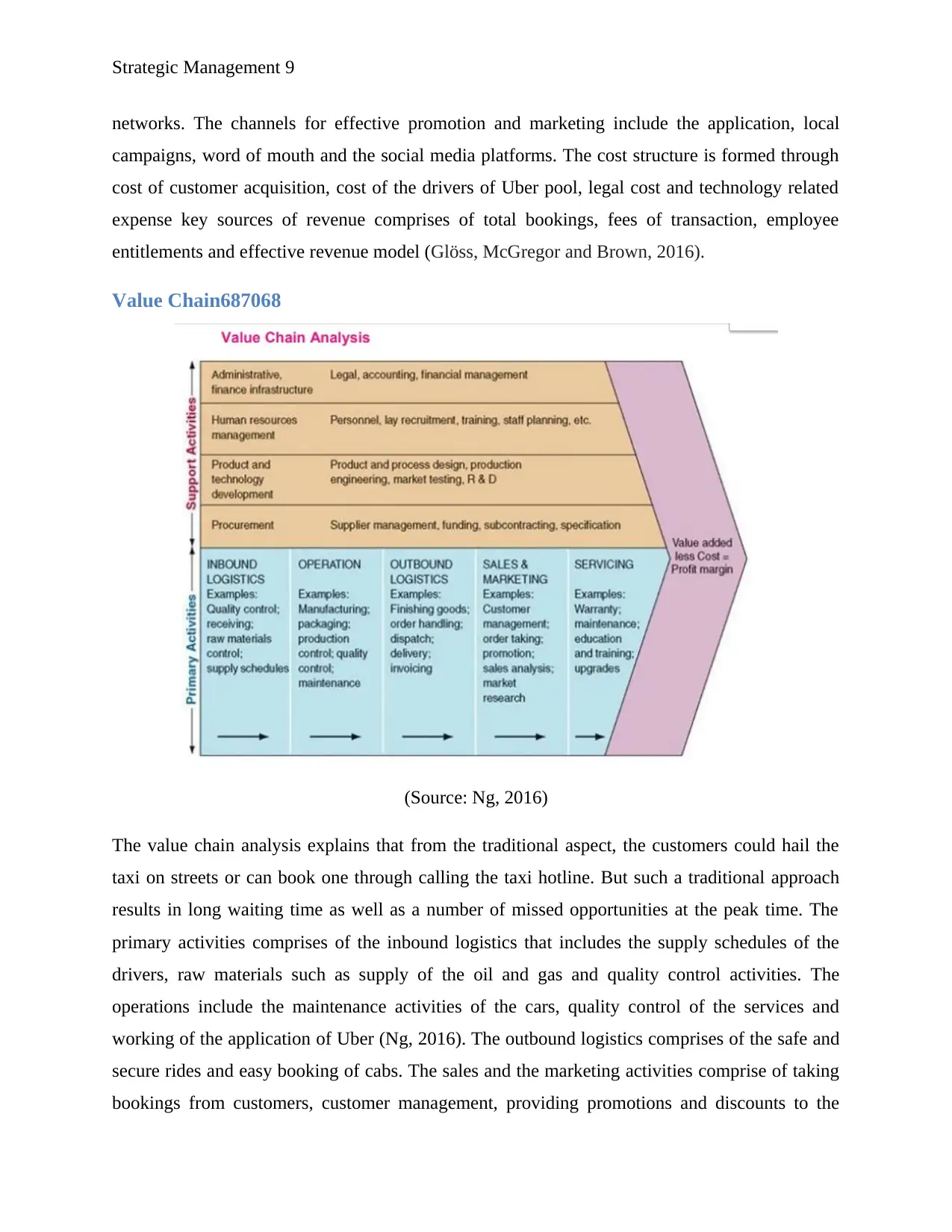
Strategic Management 9
networks. The channels for effective promotion and marketing include the application, local
campaigns, word of mouth and the social media platforms. The cost structure is formed through
cost of customer acquisition, cost of the drivers of Uber pool, legal cost and technology related
expense key sources of revenue comprises of total bookings, fees of transaction, employee
entitlements and effective revenue model (Glöss, McGregor and Brown, 2016).
Value Chain687068
(Source: Ng, 2016)
The value chain analysis explains that from the traditional aspect, the customers could hail the
taxi on streets or can book one through calling the taxi hotline. But such a traditional approach
results in long waiting time as well as a number of missed opportunities at the peak time. The
primary activities comprises of the inbound logistics that includes the supply schedules of the
drivers, raw materials such as supply of the oil and gas and quality control activities. The
operations include the maintenance activities of the cars, quality control of the services and
working of the application of Uber (Ng, 2016). The outbound logistics comprises of the safe and
secure rides and easy booking of cabs. The sales and the marketing activities comprise of taking
bookings from customers, customer management, providing promotions and discounts to the
networks. The channels for effective promotion and marketing include the application, local
campaigns, word of mouth and the social media platforms. The cost structure is formed through
cost of customer acquisition, cost of the drivers of Uber pool, legal cost and technology related
expense key sources of revenue comprises of total bookings, fees of transaction, employee
entitlements and effective revenue model (Glöss, McGregor and Brown, 2016).
Value Chain687068
(Source: Ng, 2016)
The value chain analysis explains that from the traditional aspect, the customers could hail the
taxi on streets or can book one through calling the taxi hotline. But such a traditional approach
results in long waiting time as well as a number of missed opportunities at the peak time. The
primary activities comprises of the inbound logistics that includes the supply schedules of the
drivers, raw materials such as supply of the oil and gas and quality control activities. The
operations include the maintenance activities of the cars, quality control of the services and
working of the application of Uber (Ng, 2016). The outbound logistics comprises of the safe and
secure rides and easy booking of cabs. The sales and the marketing activities comprise of taking
bookings from customers, customer management, providing promotions and discounts to the
Paraphrase This Document
Need a fresh take? Get an instant paraphrase of this document with our AI Paraphraser

Strategic Management 10
customers so that the sales can be increased. There are also activities included that comprises of
market research where it is identified which regions have high demands for the cabs. The last
primary activities include servicing where there includes training to the drivers, offering support
to the customers. there are support activities such as supply management of the drivers and the
oil and gas; product and technology development that includes effective designing of the
applications; management of the human resource that comprises of effective management of the
employees and the drivers so that operations can take place in an effective manner; and the
financial and administrative services that includes the completion of legal formalities (Moon,
2015).
VRIN
Resource Valuable Rare Costly to
Imitate
Exploited by
Organisation
Competitive
Implications
Service
Quality
Yes Somewhat Yes Yes Competitive
Parity
Level of
Satisfaction
Yes Somewhat Somewhat Yes Parity
Higher
Customer
Loyalty
Yes Yes Somewhat Yes Parity
Strong
Financial
Position
Yes Yes No Somewhat Sustained
Advantage
Innovation Yes Somewhat Yes Yes Temporary
Competitive
Advantage
(Koopman, Mitchell and Thierer, 2014).
Identification of the issues of Uber and development of strategic proposal
In the various analysis performed, it has been identified that there are several issues which have
been identified such as there are issues related security and safety of the passengers. The other
customers so that the sales can be increased. There are also activities included that comprises of
market research where it is identified which regions have high demands for the cabs. The last
primary activities include servicing where there includes training to the drivers, offering support
to the customers. there are support activities such as supply management of the drivers and the
oil and gas; product and technology development that includes effective designing of the
applications; management of the human resource that comprises of effective management of the
employees and the drivers so that operations can take place in an effective manner; and the
financial and administrative services that includes the completion of legal formalities (Moon,
2015).
VRIN
Resource Valuable Rare Costly to
Imitate
Exploited by
Organisation
Competitive
Implications
Service
Quality
Yes Somewhat Yes Yes Competitive
Parity
Level of
Satisfaction
Yes Somewhat Somewhat Yes Parity
Higher
Customer
Loyalty
Yes Yes Somewhat Yes Parity
Strong
Financial
Position
Yes Yes No Somewhat Sustained
Advantage
Innovation Yes Somewhat Yes Yes Temporary
Competitive
Advantage
(Koopman, Mitchell and Thierer, 2014).
Identification of the issues of Uber and development of strategic proposal
In the various analysis performed, it has been identified that there are several issues which have
been identified such as there are issues related security and safety of the passengers. The other
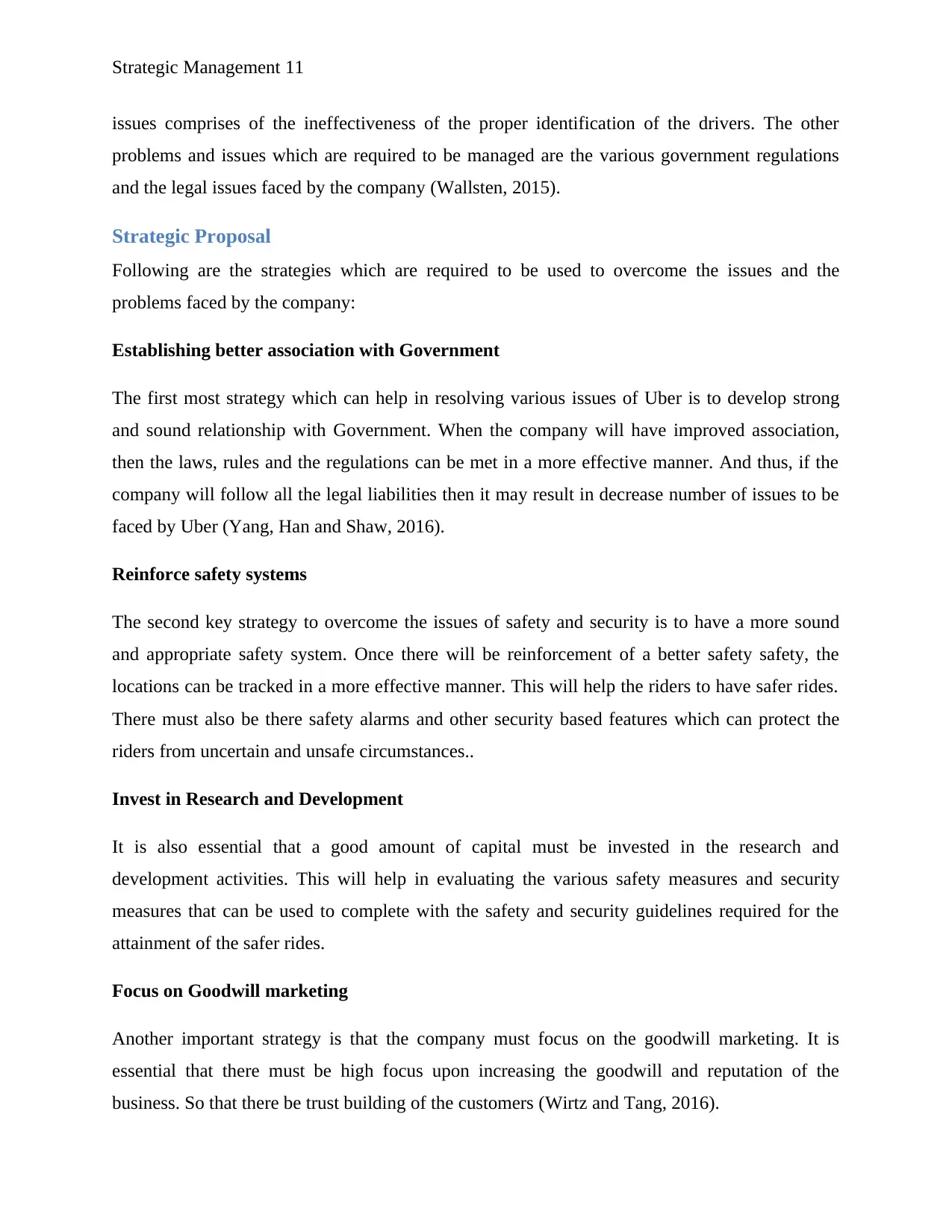
Strategic Management 11
issues comprises of the ineffectiveness of the proper identification of the drivers. The other
problems and issues which are required to be managed are the various government regulations
and the legal issues faced by the company (Wallsten, 2015).
Strategic Proposal
Following are the strategies which are required to be used to overcome the issues and the
problems faced by the company:
Establishing better association with Government
The first most strategy which can help in resolving various issues of Uber is to develop strong
and sound relationship with Government. When the company will have improved association,
then the laws, rules and the regulations can be met in a more effective manner. And thus, if the
company will follow all the legal liabilities then it may result in decrease number of issues to be
faced by Uber (Yang, Han and Shaw, 2016).
Reinforce safety systems
The second key strategy to overcome the issues of safety and security is to have a more sound
and appropriate safety system. Once there will be reinforcement of a better safety safety, the
locations can be tracked in a more effective manner. This will help the riders to have safer rides.
There must also be there safety alarms and other security based features which can protect the
riders from uncertain and unsafe circumstances..
Invest in Research and Development
It is also essential that a good amount of capital must be invested in the research and
development activities. This will help in evaluating the various safety measures and security
measures that can be used to complete with the safety and security guidelines required for the
attainment of the safer rides.
Focus on Goodwill marketing
Another important strategy is that the company must focus on the goodwill marketing. It is
essential that there must be high focus upon increasing the goodwill and reputation of the
business. So that there be trust building of the customers (Wirtz and Tang, 2016).
issues comprises of the ineffectiveness of the proper identification of the drivers. The other
problems and issues which are required to be managed are the various government regulations
and the legal issues faced by the company (Wallsten, 2015).
Strategic Proposal
Following are the strategies which are required to be used to overcome the issues and the
problems faced by the company:
Establishing better association with Government
The first most strategy which can help in resolving various issues of Uber is to develop strong
and sound relationship with Government. When the company will have improved association,
then the laws, rules and the regulations can be met in a more effective manner. And thus, if the
company will follow all the legal liabilities then it may result in decrease number of issues to be
faced by Uber (Yang, Han and Shaw, 2016).
Reinforce safety systems
The second key strategy to overcome the issues of safety and security is to have a more sound
and appropriate safety system. Once there will be reinforcement of a better safety safety, the
locations can be tracked in a more effective manner. This will help the riders to have safer rides.
There must also be there safety alarms and other security based features which can protect the
riders from uncertain and unsafe circumstances..
Invest in Research and Development
It is also essential that a good amount of capital must be invested in the research and
development activities. This will help in evaluating the various safety measures and security
measures that can be used to complete with the safety and security guidelines required for the
attainment of the safer rides.
Focus on Goodwill marketing
Another important strategy is that the company must focus on the goodwill marketing. It is
essential that there must be high focus upon increasing the goodwill and reputation of the
business. So that there be trust building of the customers (Wirtz and Tang, 2016).
⊘ This is a preview!⊘
Do you want full access?
Subscribe today to unlock all pages.

Trusted by 1+ million students worldwide
1 out of 17
Related Documents
Your All-in-One AI-Powered Toolkit for Academic Success.
+13062052269
info@desklib.com
Available 24*7 on WhatsApp / Email
![[object Object]](/_next/static/media/star-bottom.7253800d.svg)
Unlock your academic potential
Copyright © 2020–2025 A2Z Services. All Rights Reserved. Developed and managed by ZUCOL.





